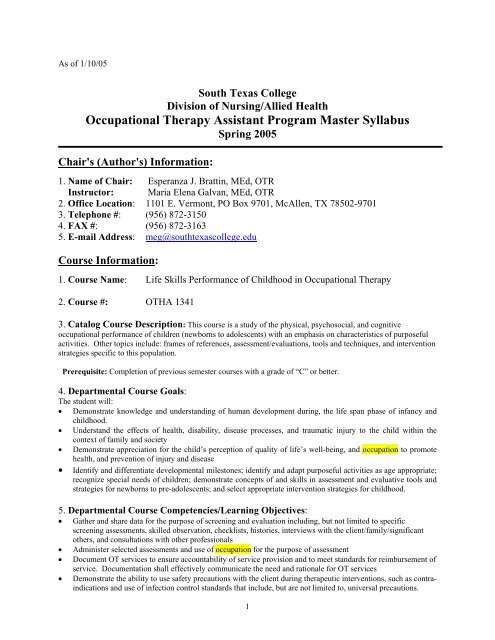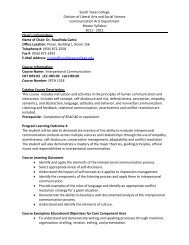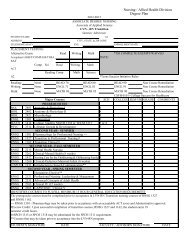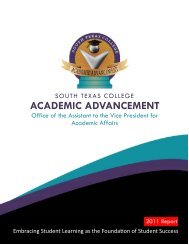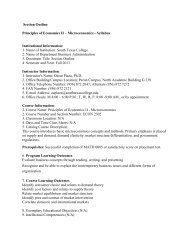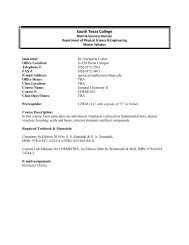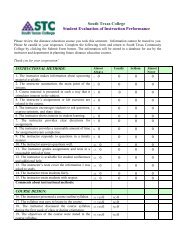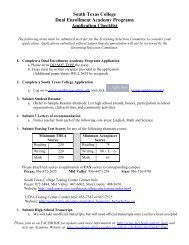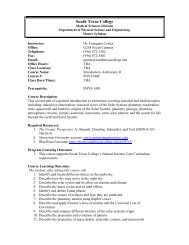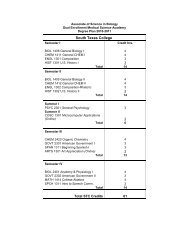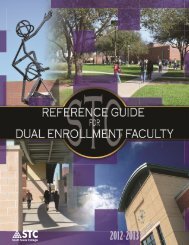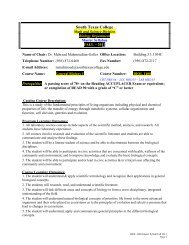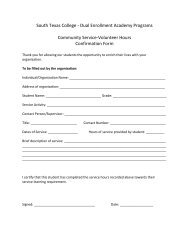OTHA 1341 - South Texas College
OTHA 1341 - South Texas College
OTHA 1341 - South Texas College
You also want an ePaper? Increase the reach of your titles
YUMPU automatically turns print PDFs into web optimized ePapers that Google loves.
As of 1/10/05<br />
<strong>South</strong> <strong>Texas</strong> <strong>College</strong><br />
Division of Nursing/Allied Health<br />
Occupational Therapy Assistant Program Master Syllabus<br />
Spring 2005<br />
Chair's (Author's) Information:<br />
1. Name of Chair: Esperanza J. Brattin, MEd, OTR<br />
Instructor: Maria Elena Galvan, MEd, OTR<br />
2. Office Location: 1101 E. Vermont, PO Box 9701, McAllen, TX 78502-9701<br />
3. Telephone #: (956) 872-3150<br />
4. FAX #: (956) 872-3163<br />
5. E-mail Address: meg@southtexascollege.edu<br />
Course Information:<br />
1. Course Name: Life Skills Performance of Childhood in Occupational Therapy<br />
2. Course #: <strong>OTHA</strong> <strong>1341</strong><br />
3. Catalog Course Description: This course is a study of the physical, psychosocial, and cognitive<br />
occupational performance of children (newborns to adolescents) with an emphasis on characteristics of purposeful<br />
activities. Other topics include: frames of references, assessment/evaluations, tools and techniques, and intervention<br />
strategies specific to this population.<br />
Prerequisite: Completion of previous semester courses with a grade of “C” or better.<br />
4. Departmental Course Goals:<br />
The student will:<br />
• Demonstrate knowledge and understanding of human development during, the life span phase of infancy and<br />
childhood.<br />
• Understand the effects of health, disability, disease processes, and traumatic injury to the child within the<br />
context of family and society<br />
• Demonstrate appreciation for the child’s perception of quality of life’s well-being, and occupation to promote<br />
health, and prevention of injury and disease<br />
• Identify and differentiate developmental milestones; identify and adapt purposeful activities as age appropriate;<br />
recognize special needs of children; demonstrate concepts of and skills in assessment and evaluative tools and<br />
strategies for newborns to pre-adolescents; and select appropriate intervention strategies for childhood.<br />
5. Departmental Course Competencies/Learning Objectives:<br />
• Gather and share data for the purpose of screening and evaluation including, but not limited to specific<br />
screening assessments, skilled observation, checklists, histories, interviews with the client/family/significant<br />
others, and consultations with other professionals<br />
• Administer selected assessments and use of occupation for the purpose of assessment<br />
• Document OT services to ensure accountability of service provision and to meet standards for reimbursement of<br />
service. Documentation shall effectively communicate the need and rationale for OT services<br />
• Demonstrate the ability to use safety precautions with the client during therapeutic interventions, such as contraindications<br />
and use of infection control standards that include, but are not limited to, universal precautions.<br />
1
• Monitor and re-assess the effects of OT intervention and the need for continued and/or modified interventions<br />
• Facilitate discharge planning by reviewing the needs of the client/family/significant others, resources, and<br />
discharge environment. These includes, but is not limited to; identification of community, human, and fiscal<br />
resources, recommendations for environmental adaptations, and home programming<br />
• Recommend the need for termination of OT services when stated outcomes have been achieved. Thus includes<br />
a summary of OT outcomes, appropriate recommendations and referrals, and discussion with the client/family<br />
of post-discharge needs<br />
• Synthesize occupational performance as it relates to development<br />
• Synthesize occupational performance as it relates to diversity and individual performance<br />
• Identify biological, psychosocial and cognitive components of occupational performance<br />
• Identify and differentiate developmental milestones<br />
• Identify and adapt purposeful activities as age appropriate<br />
• Identify the special needs of children and youth<br />
• Demonstrate concepts and skills in assessment/evaluation tools for birth through adolescence<br />
• Select appropriate intervention strategies in childhood<br />
• Identify the fundamental characteristics of common diseases and conditions<br />
• Distinguish the physical, psychosocial and cognitive characteristics of various diseases and conditions of this<br />
age group<br />
• Discuss the environmental factors of common diseases and conditions<br />
• Recognize the implications of therapeutic interventions of occupational therapy of common diseases and<br />
conditions.<br />
6. Departmental Course Requirements, Evaluation Methods, and Grading Criteria:<br />
Knowledge of course content will be evaluated by unit exams; the student will also be evaluated on his/her active<br />
participation in problem-based learning activities, oral presentations, assigned homework, completion of<br />
projects, etc. The use of other methods of integrating and evaluating learning, i.e. small group work, response<br />
papers, research projects, course portfolios, case study is optional.<br />
A student must pass the course with a grade of C or better. The breakdown of number to letter grades is:<br />
A: 100-92<br />
B: 91-83<br />
C: 82-75Ra<br />
Written or Computer Assisted Examinations:<br />
Students must take examinations at their scheduled time and date. NO MAKE UP examination will be given if the<br />
student does not notify the course instructor of his absence before the scheduled start time for the examination and is<br />
given permission to take the exam at a later time. Documentation must be submitted to the course instructor<br />
regarding the absence. It is up to each instructor to decide whether to allow the student to make-up the exam. Make<br />
up examinations must be completed before the student returns to the classroom for the next scheduled session. The<br />
format of the examination may differ from the original exam, i.e. an essay exam instead of multiple choices. Grades<br />
for make-up exams will not exceed 92.<br />
Students must demonstrate competency of at least 75% to pass all written or computer assisted tests.. If a student<br />
receives a grade below 75% in the Exam/Quiz catagory, a “D" grade will be recorded as the final course grade<br />
and the student will not be allowed to progress in the program sequence.<br />
Scholastic Misconduct: (See Student Handbook and Occupational Therapy Code of Ethics) You are expected to<br />
practice academic honesty in every aspect of this course and all other courses. Make sure you are familiar with your<br />
Student Handbook, especially the section on scholastic dishonesty. Students who engage in academic misconduct<br />
are subject to college disciplinary procedures.<br />
"Actions involving scholastic dishonesty violate the professional code of ethics and are disruptive to the academic<br />
environment. Students found guilty of scholastic dishonesty are subject to disciplinary action that may include<br />
dismissal from the program. Scholastic dishonesty encompasses, but is not limited to, cheating, plagiarism,<br />
collusion, and any act designed to give an unfair academic advantage to the student.<br />
2
A student will be given due process following the Administration of Student Discipline procedure in the STC<br />
Student Handbook. The Instructor involved or Program Chair will initiate the process, both verbally and in writing<br />
with the student.<br />
A student dismissed for scholastic dishonesty is not eligible for readmission to the STC NAH Programs."<br />
Grade Rating Standard:<br />
Final course grades will be determined by:<br />
Class participation –5%<br />
Homework assignments –10%<br />
Quizzes –20%<br />
Practical Skills Checklists or Lab Assignments –10%<br />
Special Assignments (group play, developmental testing, special reports) 10%<br />
Exams—50%<br />
Assignments:<br />
The Department requires instructors to cover major concepts through classroom lectures and discussions,<br />
supplemented by audio-visual materials. Community service experiences may also be utilized during the course to<br />
enhance learning. Assigned readings from the textbook and other learning materials and processes are at the<br />
discretion of the instructor. All written assignments must be computer generated.<br />
Developmental Testing Competency:<br />
The student will complete a developmental test on a healthy child . The student will write their own narrative report<br />
of the results and will participate in a skills check off to demonstrate appropriate skills in evaluation techniques.<br />
Pediatric Conditions/Disorders Report:<br />
The student will complete a written report on a pediatric condition or on a treatment approach relevant to this age<br />
group. Resources will include a minimum of two articles from the Internet and two resources from the library.<br />
Attendance:<br />
Regular class attendance is necessary to demonstrate adequate work habits, better assure acquisition of course<br />
content and skills, and enrich classroom activities that often rely on the participation and contribution of every<br />
student. Absenteeism will influence students’ grades in the OTA courses, just as it will have repercussions for client<br />
care and co-worker morale in the workplace.<br />
Students are expected to attend all classes, field trips, and class-related program activities as assigned. The student<br />
is responsible for his own transportation and related expenses.<br />
All absences are to be communicated directly by the student prior to class by contacting the instructor or the<br />
departmental secretary. Any absences anticipated by the student are to be discussed with the instructor ahead of<br />
time. Absences that are not communicated in this manner will be considered unsatisfactory. It is the student’s<br />
responsibility to obtain lecture notes, handouts, and assignments for the day(s) absent from class.<br />
Absenteeism may inhibit the student adequately demonstrating course competencies and thereby passing the course.<br />
Faculty will discuss and document specific concerns and consequences with the student. Reliability in attendance<br />
must be demonstrated prior to being recommended to begin a Fieldwork course.<br />
Total Maximum Absences:<br />
Spring Semester--4 class days<br />
Absences are reserved for personal illness or emergencies only. Absences exceeding the maximum number of days<br />
allowed by semester regardless of reason will place the student at risk for meeting the course objectives and must be<br />
evaluated by the faculty. Students may petition for continuance in the program if the maximum number of days is<br />
exceeded. The faculty may grant continuance in the program one time during the program sequence depending<br />
on the student’s situation/course standing. Petitioning the program is no guarantee that continuance will be granted.<br />
If continuance is granted, the student must abide by the continuance contract with any infraction of the contract<br />
3
esulting in immediate dismissal from the program. The student will not be eligible for re-admission into the OTA<br />
program.<br />
Instructor’s Policies regarding make up work, tardies, etc<br />
Punctuality is a concern for both Fieldwork educators and employers. Tardiness in getting to class or returning from<br />
breaks is often disruptive to the group and frequently has been a source of complaints from students. Occasional<br />
tardiness may be unavoidable, and students will be asked to account for such tardiness with the instructor, just as<br />
they would on the job. Arriving to class late or leaving early will be counted towards absences utilizing the<br />
following formula: 1--15 minutes = 1/4 class absence; 16--30 minutes absence = 1/2 class absence; and 31--50<br />
minute absence = 1 class absence. Habitual tardiness would indicate that an important work habit has not been<br />
demonstrated; this would require remediation prior to placement in a Fieldwork course.<br />
7. Required Textbook & Resources:<br />
Pediatric Skills for Occupational Therapy Assistants by Jean W. Solomon<br />
SCANS Information:<br />
1. Departmental Foundation Skills: (for Academic & Technical Courses)<br />
Basic Skills: The OTA Reading: locating, understanding, and interpreting written information in the course<br />
student must read, write, syllabus, textbooks, and references required and recommended in the <strong>OTHA</strong> classes.<br />
perform arithmetic and Students are also required to be able to read fieldwork placement manuals, college<br />
mathematical<br />
catalogs, graphs and class and lab schedules.<br />
operations, listen, and 4.1 Writing: communicating thoughts, ideas, information, and messages in<br />
speak effectively. These<br />
writing by providing written feedback to the instructor in the form of daily<br />
skills include:<br />
assignments and exams and by creating hand written documents such as<br />
employment letters to potential employers, home programs, instructions or<br />
directions of lab competencies; patient documentation such as SOAP notes,<br />
and other written reports summarizing applied objectives as specified by the<br />
course syllabus. Students are responsible for correct spelling of medical and<br />
non-medical terms as well as correct syntax and neatness. Students are<br />
introduced to computerized graphs, flow charts and patient documentation of<br />
OT interventions. Document OT services to ensure accountability of service<br />
provision and meet reimbursement standards.<br />
Arithmetic: performing basic computations, using basic numerical concepts such as<br />
whole numbers in distances, repetition of exercises, computing productivity reports,<br />
budgets, etc.<br />
Mathematics: approaching practical problems by discussing and understanding<br />
appropriate patient treatment times and costs as well as the interpretation of<br />
appropriate scientific/mathematical frequencies, wave lengths, for therapeutic<br />
modalities and angles/torque’s for therapeutic exercise.<br />
Listening: receiving, attending to, interpreting, and responding to verbal and nonverbal<br />
messages. Students respond to their peers daily and specially during oral<br />
presentations with graded feedback and meet with faculty during the semester to<br />
evaluate their listening skills.<br />
Speaking: organizing ideas and communicating orally by interacting with other<br />
students and faculty during class, lab time (supervised and/or unsupervised) and by<br />
delivering oral presentations as assigned.<br />
Thinking Skills: : The<br />
OTA student must think<br />
creatively, make<br />
decisions, solve<br />
problems, visualize, and<br />
know how to learn, and<br />
reason effectively. These<br />
skills include:<br />
Class groups projects utilizing problem-based learning; assignments requiring current<br />
trends and issues, recognize problems and develop solutions. Must be able to utilize<br />
strong problem solving skills. The student will be able to deal with abstract and<br />
concrete variable, define problems, collect data, establish facts, and draw valid<br />
conclusions.<br />
Creative Thinking: modifying hypothetical and client treatment techniques and<br />
interventions in the treatment plan as allowed by the applicable regulatory bodies.<br />
Decision-Making: implementing treatment programs for peer and clients and choosing<br />
the best alternative to modify the treatment techniques as allowed by law.<br />
4
Problem Solving: recognizing individual academic and /or personal problems;<br />
devising and implementing a plan of action to remediate the problem in conjunction<br />
with the instructor of program director.<br />
Knowing how to Learn: using efficient learning techniques as taught in the classroom<br />
and lab settings to acquire and apply new knowledge and skills. These techniques<br />
includes “hands on” learning. Various learning techniques are also used in the<br />
computer labs to reinforce learning of OT principles.<br />
Personal Qualities: The<br />
OTA student must<br />
display responsibility,<br />
self-esteem, sociability,<br />
self-management,<br />
integrity, and honesty.<br />
Reasoning: discovering the basic principles underlying the relationship between<br />
anatomical concepts through the implementation of treatment plans by applying these<br />
relationships to solve motor problems or to obtain a desired clinical outcome.<br />
Responsibility: exerting a high level of effort by spending additional time in open lab<br />
and persevering toward attainment of competency understanding of the human<br />
skeletal, muscular, and neurological systems. Students are also responsible for turning<br />
in assignments on time, as outlined by the syllabus and are responsible to the<br />
professional behavior components of the student handbook.<br />
Self-esteem: believing in one’s own self-worth and maintaining a positive view of one<br />
self by self-evaluation during the mid-term evaluation; participating in group<br />
discussions during classroom or lab sessions, and establishing leadership roles in the<br />
OTA class.<br />
Sociability: demonstrating understanding, friendliness, adaptability, empathy, and<br />
politeness to peers, faculty, and staff during classroom, lab, and /or clinical activities.<br />
Students are objectively evaluated in this area by the participation, work ethics and<br />
professional behaviors grading components.<br />
Self-Management: assessing oneself accurately as evaluated during the mid-term<br />
and final student evaluation; setting personal goals of academic and skills knowledge<br />
competency by obtaining at lest 75% of all grading components of the course<br />
curriculum and maintaining at least a 2.5 GPA in the <strong>OTHA</strong> courses; monitoring<br />
progress between mid-term and final student evaluations, and exhibiting self-control as<br />
indicated in the professional behavior component.<br />
Integrity and Honesty: choosing ethical courses of action as established by the work<br />
ethics and professional behaviors components. Not committing fraudulent nor<br />
negligent acts in the classroom, lab, or clinical settings.<br />
Individual and group assignments will require the student to set goals, implement time<br />
management strategies, meet course goals, and present self in a professional manner in<br />
both appearance and conduct. The student will be able to make generalizations,<br />
evaluation or decisions without immediate supervision. The student will be able to<br />
accept and carry out responsibility for direction, control and planning. The student<br />
will be able to adapt approach to the individual needs of the patients. The student will<br />
be able to conduct self in accordance with professional ethics<br />
2. Departmental Workplace Competencies: (for Technical Courses)<br />
Resources: The OTA<br />
student must identify,<br />
organize, plan, and<br />
allocate resources<br />
effectively by:<br />
• Participation in program planning of therapeutic intervention related to daily<br />
living skills work, and play/leisure with their underlying performance<br />
components; e.g., sensorimotor, cognitive, and psychosocial<br />
• Time: Selecting goal relevant academic activities such as additional laboratory<br />
time, additional computer time and independent study time, and rank them to<br />
allocate appropriate time and preparation for classroom activities, assignments,<br />
5
Information: An OTA<br />
student must be able to<br />
acquire and use<br />
information.<br />
Interpersonal: The OTA<br />
student must work with<br />
others effectively.<br />
and discussions<br />
• Material and Facilities: Utilizing OT equipment and teaching materials safely<br />
and efficiently; replacing materials in proper storage space.<br />
• Knowledge and appreciation of multi-cultural factors<br />
• Structure and function of the human body<br />
• sensorimotor, psycho-social and cognitive development throughout the lifespan<br />
• Human behavior in context of socio-cultural systems<br />
• Environmental and community effects on the individual<br />
• Basic influences contributing to health<br />
• Conditions commonly referred to occupational therapy<br />
• Documentation of occupational therapy services that addresses principles of<br />
record keeping to ensure accountability in occupational therapy service provision<br />
and adequate documentation for the reimbursement of services<br />
• Understanding the need for and use of demonstrating service competencies in<br />
screening and assessment<br />
• Acquire and evaluate information<br />
• Organize and maintain information<br />
• Interpret and communicate information<br />
• Use computers to process information<br />
• The above criteria are included in the course curriculum by: researching and<br />
collecting data from various sources preparing for research papers and projects;<br />
developing forms if needed, collecting and explaining data; developing and<br />
inventorying a record keeping system for tracking and preparing a student’s<br />
professional curriculum vitae; making oral presentations with various media; and<br />
using in-line computer data bases for research projects and providing classroom<br />
assignments from the World Wide Web.<br />
• Contribution to the formulation of occupational therapy goals and objectives based<br />
on assessment data<br />
• Fostering of prevention, health maintenance, and safety programs that are age<br />
appropriate for daily living activities, work, and play/leisure<br />
• Participate as a team member: contribute to a group effort during class,<br />
laboratory time, and during clinical practicums.<br />
• Teach others new skills: providing feedback to laboratory partners for lab checkoffs,<br />
exploring the preparing of home programs for hypothetical and actual<br />
patients, and learning the basic skills of interpersonal interaction in preparing for<br />
the professional instruction of patient care.<br />
Serve clients/customers/patients/families: introducing the creation and teaching<br />
of therapeutic procedures and home programs to patients, families and their caretakers.<br />
Demonstrate the ability to use safety precautions with the client during therapeutic<br />
intervention. Select, adapt, and sequence relevant occupations and purposeful activities<br />
that support the intervention goals.<br />
•<br />
• Exercises leadership: communicating ideas to justify position, persuading and<br />
convincing others, responsibly challenging existing policies and procedures.<br />
• Negotiate: working towards agreements involving exchange of resources between<br />
OTA students, students in other disciplines, and faculty in preparation and for<br />
working and consulting with other health care peers, students, and instructors of<br />
the health care team.<br />
• Work with Diversity: working well and seeking opportunities to work with<br />
others of diverse backgrounds. This ability is evaluated in the professional<br />
objective criteria of the course curriculum. Examples in the classroom and<br />
laboratory that are designed to prepare the student for the workplace include, but<br />
are not limited to: collaboration with other students to solve a hypothetical clinical<br />
problem; work through a classroom group conflict situation; instruct a concept to<br />
6
another student with an alternative learning approach; deal with a dissatisfied<br />
faculty member; select and use appropriate leadership styles for the class elected<br />
officers; use effective delegation techniques when researching and presenting<br />
projects; demonstrate an understanding of how therapists from different cultural<br />
backgrounds may choose various working situations, professional memberships,<br />
and specialty certifications.<br />
Systems: The OTA<br />
student must understand<br />
complex interrelationships.<br />
Technology: The OTA<br />
sudden must be able to<br />
work with a variety of<br />
technologies.<br />
• Analysis of activities of daily living, work, and play/leisure<br />
• Understanding the need for and use of demonstrating service competencies in<br />
screening and assessment<br />
• Reassessment for effect of intervention and a recommendation for need for<br />
continued and/or changed treatment<br />
• Development of problem-solving skills<br />
• Program termination including assisting in summarizing occupational therapy<br />
outcomes and contributing recommendations to maximize treatment gains<br />
• Program termination including assisting in summarizing occupational therapy<br />
outcomes and contributing recommendations to maximize treatment gains<br />
• Administration of standardized and non-standardized test on evaluations<br />
appropriate to the role of the certified occupational therapy assistant under the<br />
direction of a registered occupational therapist licensed to practice in the state of<br />
<strong>Texas</strong><br />
• Use of assessment results in relation to performance areas, activities, and<br />
adaptation principles which are age appropriate<br />
• Provision of therapeutic intervention related to occupational performance areas to<br />
include activities of daily living, work activities, and play/leisure<br />
• Application of therapeutic adaptation for accomplishment of purposeful activities<br />
(occupation): family/caretaker training, environmental adjustments, basic<br />
orthotics, and prosthetics, assistive devices, equipment, and other technologies<br />
• Reassessment for effect of intervention and a recommendation for need for<br />
continued and/or changed treatment<br />
• Apply technologies to task: OTA students are required to utilize computer<br />
technology for Internet assignments, and completing assignments requiring the use<br />
of the program’s computer labs. Students are also introduced to the use of and<br />
proper procedures for setup and operation of therapy related equipment commonly<br />
used in the clinical setting.<br />
• Maintain and Troubleshoot Equipment: Students are made aware of<br />
preventing, identifying, and solving of mechanical and technical problems with<br />
commonly used OT modality and exercise equipment.<br />
ADA Students with Disabilities Statement: Reasonable accommodations may be made that<br />
allow disabled students to be successful at STC. Accommodations may be provided for those students who submit<br />
the appropriate documentation by an outside/independent professional evaluator or agency. Students may volunteer<br />
to inform the Instructor about their disability and associated classroom limitations, if applicable. Individuals with<br />
disabilities requiring assistance or access to receive services should contact disABILITY Support Services at (956)<br />
688-2137.<br />
1.1 Demonstrate oral and written communication skills.<br />
1.2 Employ logical thinking, critical analysis, problem solving, and creativity.<br />
1.3 Demonstrate competence in basic computer use.<br />
1.4 Demonstrate knowledge and understanding of human development throughout the life span.<br />
1.5<br />
1.6 Demonstrate knowledge and understanding of the concepts of human behavior to include the behavioral and social sciences.<br />
1.7 Demonstrate knowledge and appreciation of the role of sociocultural, socioeconomic, diversity factors, and lifestyle choices in<br />
contemporary society.<br />
1.8 Appreciate the influence of social conditions and the ethical context in which humans choose and engage in occupations.<br />
1.9<br />
2.1 Be able to differentiate among occupation, activity, and purposeful activity.<br />
2.2 Understand the meaning and dynamics of occupation and purposeful activity.<br />
7
2.3 Understand and appreciate the role of occupation in the promotion of health and the prevention of disease and disability.<br />
2.4 Understand the effects of health, disability, disease processes, and traumatic injury to the individual.<br />
2.5<br />
2.6 Exhibit the ability to analyze tasks relative to performance areas, components, and contexts.<br />
2.7 Understand the need for the use of compensatory strategies when desired life tasks cannot be performed.<br />
2.8 Be familiar with the theories, models of practice, and frames of reference that underlie the practice of OT.<br />
3.1 Gather and share data for the purpose of screening and evaluation.<br />
3.2<br />
3.3 Administer selected assessments and use occupation for the purpose of assessment.<br />
3.4 Demonstrate the ability to use safety precautions with clients during the screening and evaluation process.<br />
4.2 Select, adapt, and sequence relevant occupations and purposeful activities that support the intervention goals.<br />
4.3<br />
4.4 Adapt the environment, tools, materials, and occupations, to the needs of clients and their sociocultural context.<br />
4.5 Demonstrate the ability to educate and train client/family/significant others to facilitate skills in performance areas.<br />
4.6 Demonstrate the ability to interact through written, oral, and nonverbal communication.<br />
4.7 Use therapeutic adaptation with occupations pertinent to the need of the client.<br />
4.8<br />
4.9 Exhibit the ability to use the teaching-learning process with client/family/significant others, colleagues, other health providers, and the<br />
public.<br />
4.10 Monitor and reassess the effect of OT intervention and the need for continued and/or modified intervention.<br />
4.11 Document OT services to ensure accountability of service provision and meet reimbursement standards.<br />
4.12<br />
5.1 Understand the models of health care, education, community, and social systems as they relate to OT practice.<br />
7.1 Articulate the importance of professional literature for practice and the continued development of the profession.<br />
7.2 Be able to use professional literature to make informed practice decisions, in cooperation with the OT.<br />
7.3 Know when and how to find and use informational resources.<br />
8.1 Develop an understanding of personal and professional abilities and competencies as they relate job responsibilities.<br />
8


